It is the seventh day of engagement with that accursed squirrel, the battle rages on through this bitter winter. Clearing so many traps of bait, while eluding capture has rendered him quite rotund, but not in the least bit lethargic. Each morning he taunts me at my approach to the shop. Scurrying up the entry ramp and scaling high, twenty five feet straight up the barnside, and onto the roof. There he alternates between cocking his head and peering over the roof edge and turning about to squirrel moon me with his tail in the air. Then he runs the ridge, sure footed and swift, before repelling down the back wall and disappearing under the shop to begin his day of gnawing away on floor joists. I think Norman Melville, Herman’s second cousin twice removed, said it best in his seminal work, The Squirrel, “That inscrutable thing is chiefly what I hate; and be the gray squirrel agent, or be the gray squirrel principal, I will wreak that hate upon him”. Only a harpoon of exceptional range could be the solution…
And now, back to reality…
This piece would probably be of no use to a person experienced with a crossbow, but it may be of interest for a gun guy looking to learn about another type of hunting equipment or a way to sharpen hunting skills. My intention is jump in and thrash until I figure it all out or give up.
![]()
Firearms have been central to my hunting experiences, with only passing exposure to recurve and compound bows. Quite frankly, having access to a wide range of firearms, and a record of successful hunting seasons, there was no obvious need to develop archery skills. Unfortunately, deer hunting can get quite predictable; wander into the woods, shoot encountered deer, convert to table fare, repeat in subsequent seasons. Introducing handguns and muzzle loaders brought fresh challenges to the process and extended the number of hunting days.
One day, after running the hundredth cleaning patch down the bore of a 50 caliber muzzle loader, halfway through the process, I thought there had to be a better way. Archery with a bow; long, recurve or compound, required too much athleticism in terms of hand – eye coordination, muscle control. It required becoming part of a dynamic system that would have me hold the bow under strain, aim while compensating for arcing trajectory and releasing an arrow while holding steady for the longest “lock time” of any weapon. So I needed something like a bow, only more manageable.
The crossbow is considered easier to master than a traditional bow. It replaces the demands on an archer’s athleticism with the crossbow’s mechanisms and fixed geometry. The crossbow’s draw rate and power stroke are consistent, the bow is supported by a forearm and shoulder stock, not the archer’s arms and hands. A trigger mechanism uniformly releases the arrow, and a telescopic sight is often incorporated as an aiming device. Unlike a traditional bow that is drawn and held under stress as an opportunity for a shot develops, the crossbow can be carried cocked while hunting for at least four hours before being uncocked. The crossbow is virtually without recoil or report, both significant benefits.
A crossbow is more difficult to master for hunting applications than a firearm; velocity is much lower, the arc of trajectory is much more acute and the effective range is much shorter. Shooting a low density projectile, retention of velocity is brief, therefore what little kinetic energy or momentum is generated at release quickly dissipates. An archer requires enhanced hunting and weapon skills to get very close to game, to achieve critical shot placement, to stalk or still hunt and to camouflage for concealment. Apparently, the crossbows offsetting benefits make the required efforts worthwhile.
Approximately ten years ago, hunting with a crossbow was permitted in only six states, mostly as an accommodation to the physically impaired. Currently, forty nine states permit crossbow hunting, with holdout Oregon moving in that direction, and with broad participation. Some states place the crossbow into the category of archery hunting and follow those state hunting regulations. Other states lump the use of a crossbow into firearm seasons and ban them from use during archery season. With so many hunters finding utility in the crossbow, my thought was that I might try my hand at hog and deer hunting if I could build proficiency in the off season. So I set out to sort things out.
It was reasonable to begin at the beginning…
Crossbow related social media discussions can be helpful, but they can also be as contentious, exaggerated and repetitive as firearm discussion. Fortunately, companies participating within the industry do a good job of presenting and explaining respective products features, with any number of related industry and sport organizations and seasoned associated publications providing standards. Ultimately, personal use, a target, a chronograph, and ballistic gel make assessment and interpretation a whole lot less subjective. Initially, state hunting laws set the foundation for equipment selection.
Maine Crossbow Equipment Laws
Required Features:
- Only crossbows with a shoulder-type stock may be used.
- Draw weight must be at least 100 pounds (there is no max).
- Arrowheads, including mechanical broadheads when open, must be at least ⅞ inch wide.
- Crossbows must be equipped with a mechanical trigger safety device in working condition.
Prohibited Features:
- Hand-held pistol-type crossbows are prohibited
- Arrows with explosive or poisonous tips are prohibited
Optional, but Allowed Features:
- Crossbows equipped with scopes or sights may be used.
While crossbows are required to have a minimum draw weight of 100 pounds, a traditional bow must only meet a 35 pound draw weight minimum or 45 pounds for moose hunting. Much of the difference between crossbow and traditional bow draw weight is mitigated by “power stroke”, or “draw length” for a traditional bow. Draw weight is the maximum amount of resistance, measured in pounds, that will occur while moving the bow string from at rest to fully drawn or cocked. Draw length, or power stroke, is the distance the bow string moves from at rest to fully drawn (bow) or cocked (cross bow).
Draw weight defines how much force is applied to an arrow, power stroke or draw length determines persistence of that force. Think of draw weight as a rifle cartridge that applies a pressure behind a bullet and power stroke or draw length as barrel length that determines for how long the pressure persists. A traditional bow with a 35 pound draw rate and 30″ draw length may generate close to the same velocity as a crossbow with a 100 pound draw weight and 12.5″ power stroke. The combination of draw weight and power stroke or draw length infer the level of foot per second performance. Foot per second performance can be interpreted into kinetic energy, momentum and trajectory… an arrow’s path.
Wandering through the wilderness…
Maine has a big game wildlife population that ranges from deer to black bear and moose. Additionally, my travels take me to other locations that have their own types of wildlife. In attempting to research the crossbow power that might be necessary for hunting these type of game, I found two spec standards that were referenced constantly, 150 lbs to 175 lbs draw rate and 300 fps / 400 grain arrow velocity for hunting game the size of deer or larger. The draw rate recommendation increased to 200 lbs for large bear and other dangerous game without a statement of velocity to follow.
Sifting through product specifications, it became obvious that much of the previously information noted was obsolete. Mostly published between 2007 and 2012, the referenced pull rates now yield significantly higher velocity through refinements to crossbow limbs, cams, power stroke, and overall geometry. So I concluded that I could pretty much ignore draw weight and power stroke as a statement of power and shift to foot per second ratings.
Kinetic Energy would seems to rule as the crossbow power indicator and is reported alongside velocity, similar to firearms. In reality, the two indices are bound together by basic laws of physics with kinetic energy increasing to the square of the velocity, KE = 0.5 x mv2 . KE seems often referenced as a potential for arrow penetration. Within the world of smokeless powder driven projectiles, kinetic energy tends to arise as a measurement of energy transferred at bullet termination and bullet momentum, p = mv, tends to suggest potential penetration. I would guess either or both of these indicators are important to crossbow hunters as KE is generated in short supply, so even minor increments of greater or lessor values are significant.
Beyond velocity and energy, crossbow, penetration is determined substantially by the characteristics of the projectile. In the case of a firearm, a rapidly expanding bullet penetrates less than a non-expanding bullet moving along at the same velocity, with the penetration diminished at some ratio to the increasing frontal area of the bullet. Arrow heads tend to have a static frontal area, although not all as some arrowheads open on impact or during penetrations, however, arrowhead size, shape, sharpness, frontal area, and overall arrow weight all figure into penetration.
And how did you get here, Joe?

| Brand | Barnett Crossbows |
| Model | Whitetail Hunter® Pro |
| SKU | 78113 |
| Trigger | TriggerTech |
| Velocity | 380 fps / 380 Gr Arrow |
| Kinetic Energy | 122 ft-lbs |
| Draw Rate | 160 lbs |
| Power Stroke | 13.625″ |
| Dimensions | 35.25″x17.75″ |
| Axle to Axle | 16.125″ |
| Weight | 6.4 Lbs |
| MSRP | $599.99 |
The Barnett Whitetail Hunter Pro’s velocity rating is high enough for any crossbow hunting – shooting I might be doing. The brand has a good reputation, the product has been well received by hunters and it is available as a complete package right down to arrows and scope. Price loomed large in my selection process, but not enough to settle for a less than a proven solid, quality product. If my interest in crossbows were sustained beyond this project, I would have made a wise investment. If my interest in crossbows waned at the conclusion of the project, I would not feel nearly as bad as if I purchased a $1,200 crossbow with feature nuance that would be lost on a novice… that would be me.
Example? Sure. The Barnett Ghost 420, as in 420 fps arrow velocity, offers numerous enhancements over the Whitetail Pro; step through Carbonlite Riser, higher draw weight, longer power stoke, higher velocity, higher kinetic energy, improved scope, etc. The penalties are minor, a little more weight and a little bit wider and a little bit longer; an easy trade for enhanced features and the price is reflective of the bump in performance.
The Barnett Ghost 420 may very well be a Ferrari and the Whitetail a Ford truck, but for this point in time, and serving my application and level of experience, the Ford truck would better serve. When or if I get to the point were my skills support longer game taking distances and game gets bigger and more aggressive, I will revisit my selection. For the moment, I think I am all set.
Some Whitetail Hunter Pro features
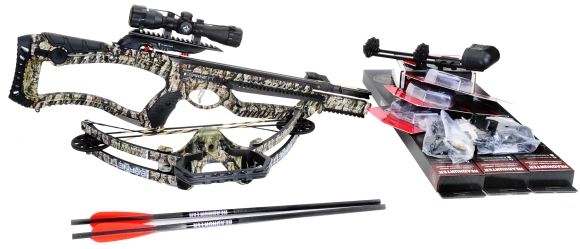
The Barnett Whitetail Pro is shipped as two major components, the riser/limb assembly and the stock. I would not really label this as “assembly required” as the two pieces slide together, oriented with stock dowel and keyed, then the parts are secured with one central bolt. The extended front stirrup not only serves as a really good place to put your foot while cocking the crossbow and the stirrup dampens vibrations.
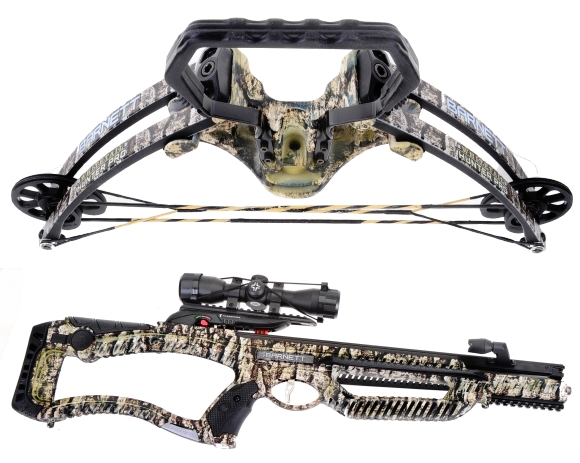 Included with the Whitetail Pro: 4x32mm Multi-Reticle Scope, rope cocking device,side mount quiver, two 20” Headhunter™ arrows with field tips, string dampeners, and lubrication wax.
Included with the Whitetail Pro: 4x32mm Multi-Reticle Scope, rope cocking device,side mount quiver, two 20” Headhunter™ arrows with field tips, string dampeners, and lubrication wax.
One of the major cautions regarding use of a crossbow is against dry fire. In broader definition, dry fire is releasing a cocked bow without an arrow in place which will nearly 100% of the time damage a crossbow by damaging strings, or cams or fracturing bow limbs or all of the preceding. Similar damage can be sustained by using arrows lighter than defined in the product manual or in the event a nock fails and allows the string to pass over or under the arrow with little load resistance.
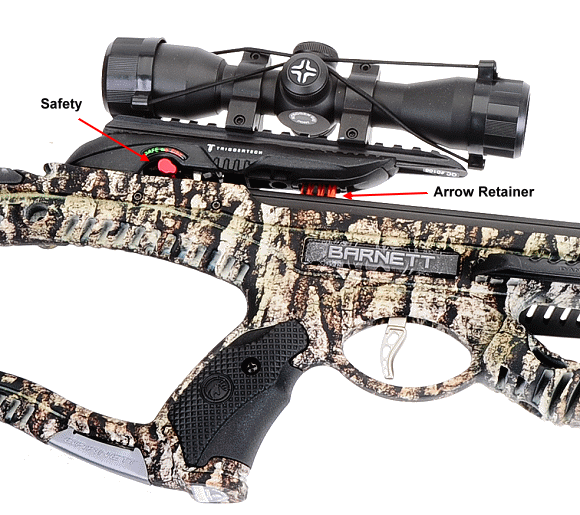
The Barnett Whitetail Hunter Pro provides a number of systems to help prevent a dry fire. The Soft-Lok Floating Bristle Arrow Retainer applies downward pressure on a properly loaded arrow to keep the arrow secure and with the nock in alignment with the string. The Anti-Dry Fire Trigger System prevents firing until an arrow is fully inserted. The Manual Safety defaults into the safe position when cocked and cannot be moved to the fire position until an arrow is fully inserted. Barnett crossbow arrows have crescent shaped nocks to additionally guide the string to center and lesson the chance of the string going over or under the arrow shaft.
Like a small rowing machine…
A 160 lb draw rate Crossbow is a bit too much for some folks… me, to cock by hand, so it is fortunate that Barnett includes a rope cocking device with the Whitetail Pro that cuts required effort in half. The rope wraps around a groove in the rear of the stock, goes down on either side of the arrow track and hooks onto the string in both sides. The archer puts his foot through the stirrup with the crossbow pointing down and then pulls up on both handles until the bow string clicks into place..
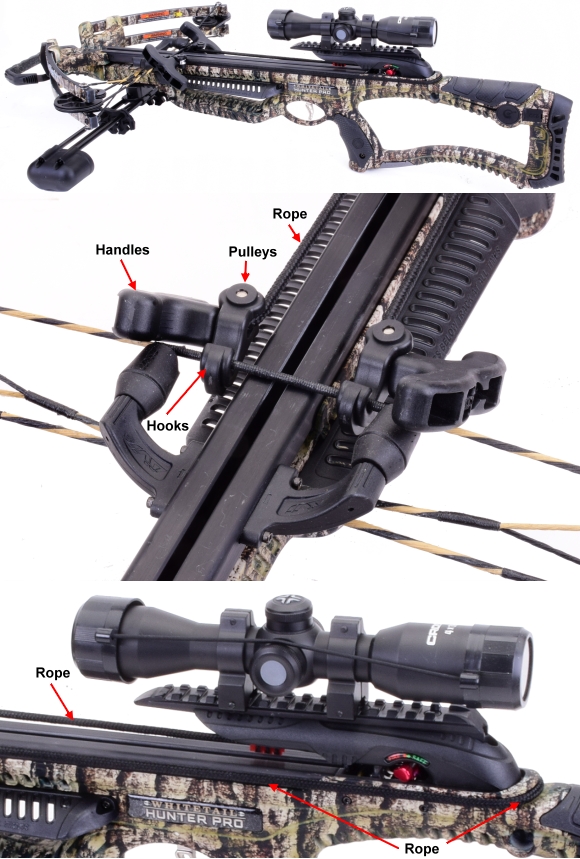
I am old guy who does not subject himself to the rigors and repetitions of excessive physical challenge. Still, the effort required to cock the Whitetail with the included rope cocking device was no big deal and that was the approach taken throughout this checkout. Would I spend the day shooting the Whitetail Pro for target practice using only the rope cocker? Probably, as it provides enough mechanical advantage to the process to make it its use more than reasonable. For a heavier draw weight crossbow, or perhaps during intense proficiency building, I might go to the optional crank cocking device which reduced cocking effort to 17 lbs.
The pointy end…
The Whitetail Hunter Pro requires the use of arrows with a minimum weight of 400 grains to provide sufficient resistance when the crossbow is fired. Excessively lighter arrows could cause failures similar to dry firing the crossbow. Subsequently, uncocking the bow must be done by firing a standard arrow or a special decocking arrow that is significantly heavier in weight and assembled with a blunt tip that would penetrate less. Pictured below, bottom left, a closed 100 grain BloodSport Chisel Tip Grave Digger with cross opening blades. Right, blades opened and broadhead installed on Barnett Headhunter arrow. Below left, a 100 grain field point as packaged with arrows.
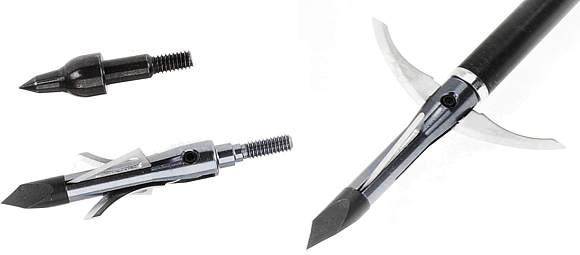
Barnett Headhunter arrows suitable for use with the Whitetail Hunter Pro are available in 20″ (Labeled 415 Grains) and 22″ (Labeled 435 Grains) lengths, the measurement of the shaft between the arrow head and nock, but the weight includes nock and field or broadhead arrow head. 20″ arrows weight checked at 300 grains +/- 5 grains. Field tips and broad heads scale checked 100 grains +2/-4 grains.
Getting it to do something…
Barnett’s crossbow manual is comprehensive and covered all products with cautions and well illustrated operating instruction. Only a few minutes were required to assemble the bow and problems encountered were minimal. In fact, I am only carrying three questions into the next part within this brief series. The manuals and other collateral; material call for a 400 grain minimum weight arrow, yet the arrow weight used to set the 380 fps weighed 380 grains and assembled arrows frequently scaled 395 grains. Not huge deviations from standard, but I would like to know what a reasonable weight variation to the low side is reasonable.
The bow was supplied with a side mount quiver that I was not able to mount. The mount bumped into the riser before it could be leveled to and slipped on the Picatinny rail attaching point, so I could use some clarification. I used the cross mounted quiver which was also in the box and it worked without a hitch.
There was a small hardware bracket packed in the box that does not make an appearance on any manual page or drawing. So far I have not been able to get it defined, but I will persist. The part is not marked, so I can’t look it up and the package is unmarked. Often, manufacturers will put line drawing of bits and pieces in the front of the manual to make sure the customer can identify all parts and determine whether or not the part is used on the subject model. Perhaps Barnett might post exploded drawings of each product within their website documentation.
Get a bigger target….
I did have an archery target that was used a while back, quite effectively, with a compound bow. It offered little resistance to arrows from the crossbow, so an 18″ cube target made to stop a 450 fps arrow was sourced. The Morrell target stopped arrows regardless where they hit on the target and arrows could be pulled by hand.
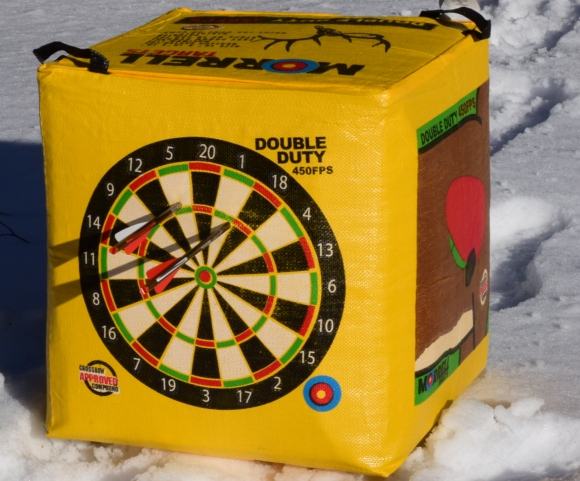
The first two shots, forty yards, out of the Whitetail Hunter Pro and my first two shots from a crossbow. The arrows are about 2 1/2″ apart. Checking social media to get a sense of what goals I might set for improving my performance was not as easy as I hoped. Many current social media sites were comprised of the same handful of guys, each assuring the other that they are using the same crossbow, arrows and accessories and all shooting sub one inch group at 100 yards and expressing disappointment in the accuracy tweak they attempted. Searching social media with a 2010 to 2012 date range yielded popular satisfaction with 2″ groups at 40 yards. I do not have sufficient experience and valid data to know if equipment and archers have gotten much, much better, or if much is a grand social media fabrication. Further research is needed, but I felt I was at least at a good starting place with the potential for much improvement.
The plan…
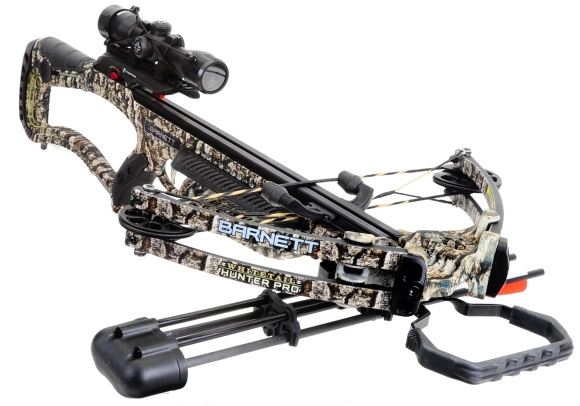
First, I’ll clear the foot of snow that fell last night. Then… then I will shoot the Barnett Whitetail Hunter Pro until I shake my crossbow trepidation and have a greater sense of familiarity with its process. I’ll get answers to my previously stated tech questions and see about taking Maine’s crossbow hunters safety course. I can definitely place the tags “interesting”, “fun” and “challenging” on the experience. I think there is more here worth learning.

Email Notification